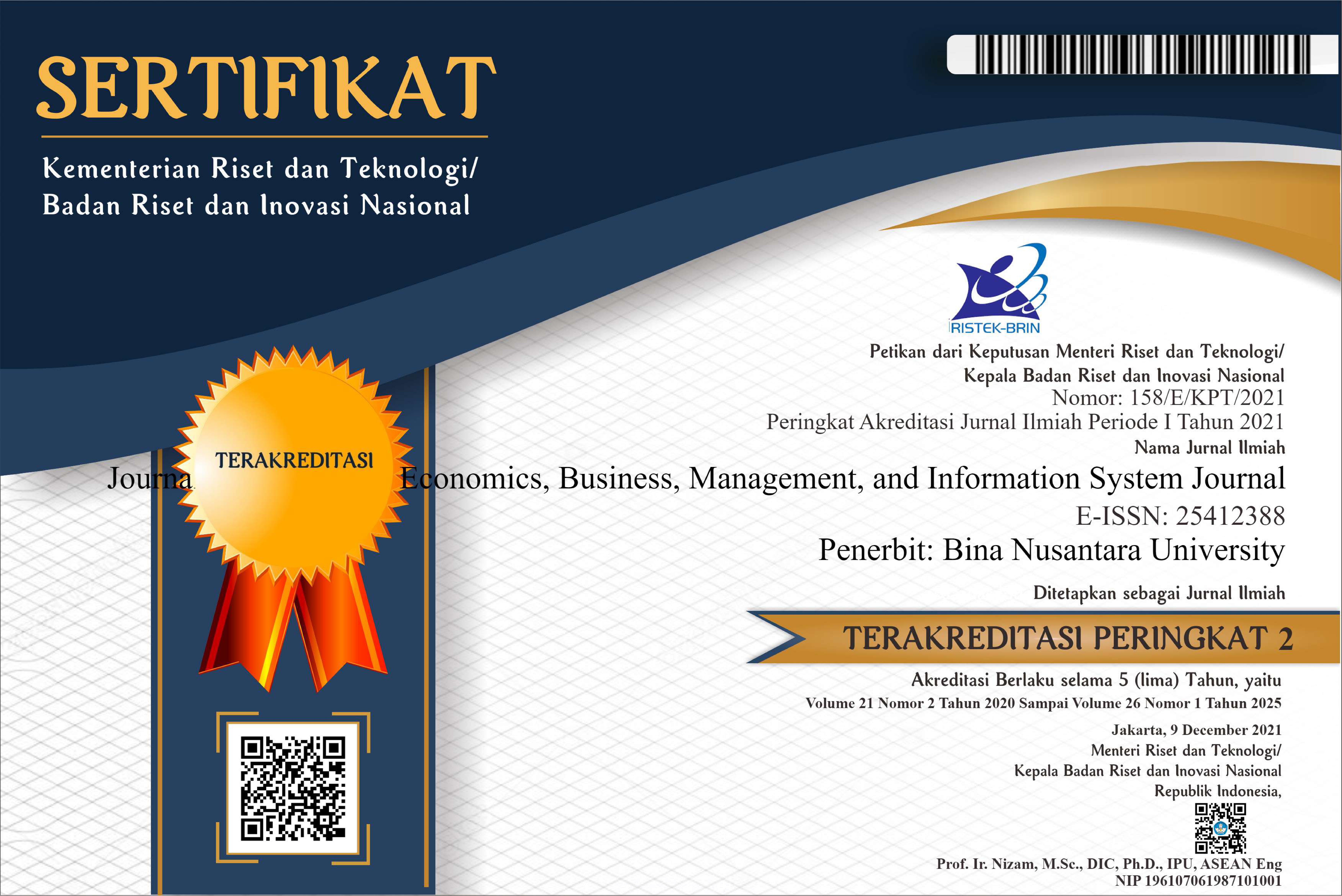Enhancing Business Performance through Learning Organization and Knowledge Sharing Capability: the Mediating Effect of Innovation Capability using PLS Method
DOI:
https://doi.org/10.21512/tw.v15i2.623Keywords:
learning organization, knowledge sharing capability, innovation capability, business performance, PLS, mediating effectAbstract
This research aims to analyze descriptive condition of Learning Organization, Knowledge Sharing Capability, Innovation Capability, and Business Performance perceived by employees at PT SIT GLOBAL SYSTEMS, an IT consultant company. Besides, research is to analyze influence of Learning Organization and Knowledge Sharing Capability (exogenous variables) on Innovation Capability and Business Performance (endogenous variables) in the company. This research used descriptive statistics and associative methods, with primary and secondary data obtained from observation, interview, and questionnaire to 50 employees as respondents. The data then were analyzed with SmartPLS 2.0 software by measuring loading factor (convergent validity), cross loading (discriminant validity), and reliability for outer model, and interpretation of R2 value, path coefficient, and total effect for inner model. Research found that the descriptive condition of Learning Organization and Knowledge Sharing Capability was on average level, whereas the descriptive condition of Innovation Capability and Business Performance was perceived well by the employees. Research concluded that Learning Organization has positive and significant influence on Innovation Capability; Knowledge Sharing Capability has positive and significant influence on Innovation Capability; Innovation Capability has positive and significant influence on Business Performance; Learning Organization has positive and significant influence on Business Performance, directly and indirectly through Innovation Capability; and Knowledge Sharing Capability has positive and significant influence on Business Performance, directly and indirectly through Innovation Capability.
Plum Analytics
References
Ahmed, P.K., (1998). Culture and climate for innovation. European Journal of Innovation Management, 1(1), 30–43.
Baron, R.M., & Kenny, D.A. (1986). The Moderator-Mediator variable distinction in Social Psychological research: Conceptual, strategic, and statistical considerations. Journal of Personality and Social Psychology, 51, 1173–1182.
Burgelman, R.A., Maidique, M.A., & Wheelwright, S.C. (2004). Strategic Management of Technology and Innovation. McGraw.
Cabrera A., Collins, W.C., & Selgado, J.F. (2006). Determinants of individual engagement in knowledge sharing. International Journal of Human Resource Management, 17(2), 245–264.
Calantone, R.J., Cavusgil, S.T., & Zhao, Y. (2002). Learning orientation, firm innovation capability, and firm performance. Industrial Marketing Management, 31, 515–524.
Collins, C.J., & Smith, K.G. (2006). Knowledge Exchange and Combination: the Role of Human Resource Practices in the Performance of High-Technology Firms. Academy of Management Journal, 49(3), 544–560.
Connelly, C. E and Kelloway, E. K. (2003). Predictors of employees perceptions of knowledge sharing cultures. Harvard Business Review, 71, 78–91.
Dumaine, B. (1994). Mr. Learning Organization. Fortune, 130, 147.
Fatt, C.K. and Khin, E.W.S. (2010). The social-technical view of knowledge management in services industries. Journal of Social Science, 6, 256–264.
Gopalakrishnan, S. and Damanpour, F. (1997). A review of innovation research in economics, sociology and technology management. Omega, International Journal of Management Science, 25(1), 15–29.
Halal, W. E. (2008). The Logic of Knowledge: Making Sense of the New Principles That Govern Organizations and Economics. Available at http://home.gwu.edu/uhalal/Articles/Logic.pdf
Ho, Li-An. (2011). Meditation, learning, organizational innovation and performance. Industrial Management & Data Systems, 111(1), 113–131.
Hurley, Robert F., and Hult, G.T.M. (1998). Innovation, Market Orientation and Organizational learning: an Integration and Empirical Examination. Journal of Marketing, 62(3), 42–54.
Jaw, B.S., and Liu, W. (2003). Promoting Organizational Learning and Self-Renewal in Taiwanese Companies: The Role of HRM. Human Research Management, 42(3), 223–241.
Kasim, Raja Suzana Raja; Noh, Ismayaza. (2012). The impact of organizational innovativeness on the performance of the university: An analysis among selected Malaysian private universities. International Conference on Innovation Management and Technology Research (ICIMTR), 21-22 May 2012
Keban, Yeremias T. (1995). Indikator Kinerja Pemda, Pendekatan. Manajemen dan Kebijakan, Yogyakarta : Fisip UGM
Kim, D. H. (1993). A framework for integrating individual learning and organizational learning. Sloan Management Review, 37–82.
Kim, S., and Lee, H. (2006). The Impact of Organizational Context and Information Tech on Employee Knowledge- Sharing Capabilities. Public Administration Review, 66(3), 370–385.
Kolb, D. A. (1976). The Learning Style Inventory. Boston: McBer.
Maryani, Donna M., Hapsari, N. (2010). Building Learning Culture Towards A Learning Organization to Empower Employee’s Knowledge. ComTech, 1(2), 1196–1209.
Mathuramaytha, Chonticha. (2012). Developing Knowledge-Sharing Capabilities Influence Innovation Capabilities in Organizations – a Theoretical Model. Journal of International Conference on Education and Management Innovation IPEDR, 30.
Michael, DN. (1985). On Learning to Plan and Planning to Learn. San Fransisco: Jossey-bBass.
Nonaka, I., Konno, N. (1998). The concept of `Ba': building a foundation for knowledge creation. California Management Review, 40(3), 40–54.
Sekaran, U. (2007). Research Methods for Business, Jakarta: Salemba Empat
Senge, P. (1990). The fifth discipline: The art and practice of learning organization. Century Business.
South Korean Embassy for Indonesia. (2013). Accessed from http://idn.mofa.go.kr/worldlanguage/asia/idn/mission/greetings/index.jsp
Sugiyono. (2005). Statistika untuk Penelitian. Bandung: CV Alfabeta
Yamin, S., & Kurniawan, H. (2009). Structural Equation Modeling. Jakarta: Salemba Infotek.
Downloads
Published
Issue
Section
License
Authors who publish with this journal agree to the following terms:
a. Authors retain copyright and grant the journal right of first publication with the work simultaneously licensed under a Creative Commons Attribution License - Share Alike that allows others to share the work with an acknowledgment of the work's authorship and initial publication in this journal.
b. Authors are able to enter into separate, additional contractual arrangements for the non-exclusive distribution of the journal's published version of the work (e.g., post it to an institutional repository or publish it in a book), with an acknowledgment of its initial publication in this journal.
c. Authors are permitted and encouraged to post their work online (e.g., in institutional repositories or on their website) prior to and during the submission process, as it can lead to productive exchanges, as well as earlier and greater citation of published work.
USER RIGHTS
All articles published Open Access will be immediately and permanently free for everyone to read and download. We are continuously working with our author communities to select the best choice of license options, currently being defined for this journal as follows: Creative Commons Attribution-Share Alike (CC BY-SA)

















